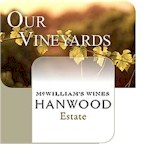


So said John James McWilliam when he arrived in Hanwood in 1913. The development of the Riverina region as a major wine producing area was primarily due to the foresight of the McWilliam family. The Riverina, and Hanwood in particular, was an area John James McWilliam the son of McWilliam's founder, Samuel McWilliam had identified earlier as having the potential to service the growing domestic and export wine markets.

In 1913, John James McWilliam planted the first vines at Hanwood, just 8kms south of the thriving agricultural town of Griffith in New South Wales; and in 1917 he established McWilliam's Hanwood winery. Today, this same winery is a large modern facility, one of the largest in the region - with an average crush of 18,000 tonnes and a storage capacity of more than 22 million litres.
Not only was he responsible for the trial of premium varieties previously unknown in the district, he was also responsible for leading the way in developing the winery technology necessary to produce table wines in a hot summer climate. Just as John James led the way in 1913, so it was Glen McWilliam that pioneered the region's move into table wines during the mid-1950s.
The Riverina is today credited with producing more than two-thirds of New South Wales wine and almost one-quarter of Australia's total wine production. The constant, even rainfall, rich and fertile soil and warm temperatures during the ripening season make the Riverina ideally suited to viticulture.
McWilliam's Hanwood Estate - one of Australia's leading premium quality wine ranges, is a blend of high quality fruit from a range of vineyard sites within South Eastern Australia. McWilliam's Hanwood Chardonnay is one of the most consistently awarded white wines at its price point and arguably the fastest growing Chardonnay in the domestic market.
Fruit is predominantly sourced from the Riverina and Hilltops regions in New South Wales, the Yarra Valley in Victoria, and Coonawarra in South Australia. The diverse fruit supply provides the winemaking team with a broader range of blending options and enables them to produce a range of wines that are high in quality and consistent in style from one year to the next.
McWilliam's Hanwood winery is distinguished by its barrel-shaped cellar door tasting room and the large array of old bottles and winery memorabilia displayed in a 17 metre-long museum in the shape of a bottle. McWilliam's range of red, white and fortified wines, as well as limited-release Cellar Door only wines, are available for tasting at McWilliam's Hanwood Cellar Door.
























